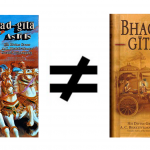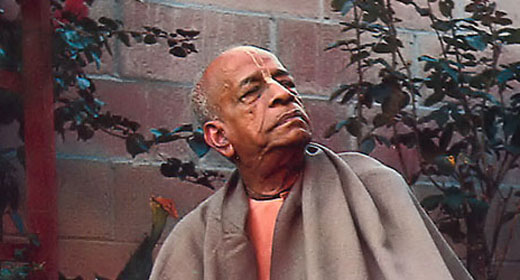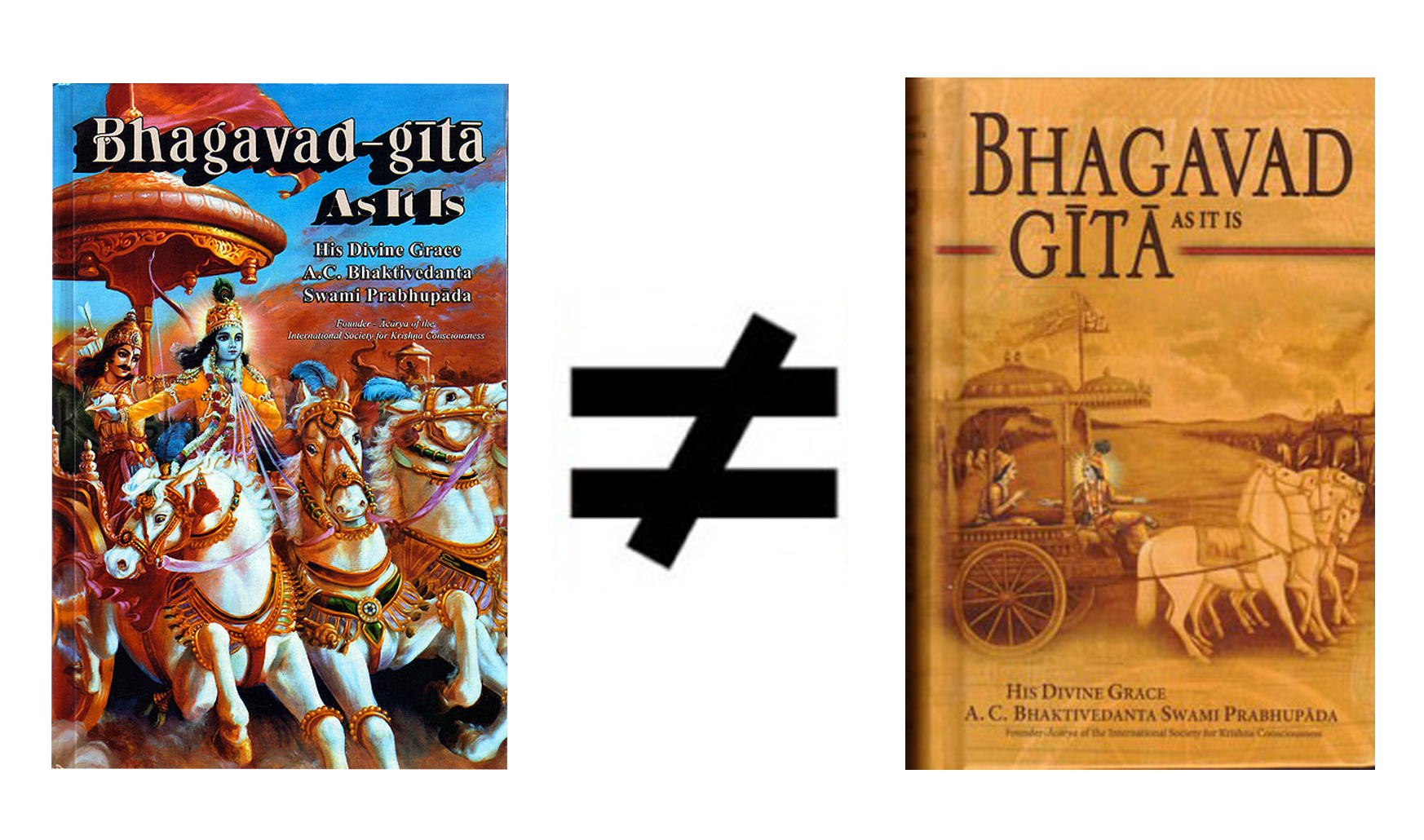“Our editing is to correct grammatical and spelling errors only, without interpolation of style or philosophy.” (Letter to Rupanuga, 2/17/70) Previous evaluations of the editorial changes focused on descriptions of the changes and references to pre-publication drafts rather than a factual quantification and comparative philosophical analysis. This article presents a scientific evaluation of the Bhagavad-gita As It Is and the Teachings of Lord Caitanya. The results demonstrate if the revised editions followed Srila Prabhupada’s editorial policy and if they are genuine, authentic revisions that preserve the original content, philosophy and style.
Two Editions of TLC Compared
The 1968 edition of the Teachings of Lord Caitanya (TLC) was last printed by BBT in 1972. Its content and words are substantially different from the 1974 BBT (USA) edition and subsequent revisions. Over 100 pages of the 1968 first printing and the 1974 edition were compared. Nearly 12,000 words were deleted from one third of the first edition, the equivalent of 24 full pages of text. At this rate, the total number of deleted words for the entire book is estimated at 33,000, the equivalent of 66 full pages of text missing from a book 310 pages long. Substantial information and philosophy was deleted along with the thousands of words. Clearly, the 1968 first edition contains substantial content not found in the 1974 edition and subsequent revisions.
Method of Counting Deleted Words
How were deleted words determined? The 1968 and 1974 editions were compared word for word, sentence by sentence. Words that appeared in the first edition but were deleted (omitted) from the 1974 edition were marked as deleted words. Great care was taken not to count words that were rearranged in the same sentence or which appeared in another nearby sentence or paragraph. Words that were changed for spelling, capitalization or punctuation were not counted as deleted words. Words for citation references that were changed to the standard format were not counted as deleted words. In the following example, none of the words were counted as deleted words:
1968: Srimad Bhagwatam, Tenth Canto, Ninth Chapter, 12th Verse
1974: (Bhag. 10.9.12)
Deleted words were counted whether or not the words were replaced by other words. In the following example, the words “you” and “I” were counted as deleted from the first edition even though they were replaced by substitutes in the 1974 edition.
“It is not displayed by you or I” (1968, p.1)
“It is not displayed by man or any other creature.” (1974, p. 1)
Results for TLC
The results were extensive. In 112 pages, 11,831 words were deleted. In the Introduction alone, 3695 words were deleted from 18 pages, the equivalent of 7.4 full pages of text. Approximately 40% of the total words were deleted from the Introduction. In the paragraph describing the ten offenses to the Holy Name, 218 words were deleted out of 524 total words, meaning that 42% of the words in this paragraph were deleted (1968, p. 27-28).
Analysis of the Content of Deleted and Inserted Words
The content of deleted words was examined. Many deleted phrases, sentences and paragraphs contained information, standards and philosophy that were not rewritten or relocated in the 1974 edition, i.e., they were deleted completely from the book. The following are examples of deleted information, standards and philosophy; the deleted words are in bold type.
Examples of deleted information include:
1. “Other devotees had approached Chaitanya and asked Him to forgive Junior Haridas, but Chaitanya replied, ‘You all go live with him and forgive him. I’ll stay alone.‘” (1968, p. 3)
2. “…Brahma created the whole human society, animal society, everything.” (1968, p. 14)
Examples of deleted standards include:
1. “… one should not eat anything other than Krishna prasadam (food offered to Krishna)” (1968, p. 28)
Compare with the 1974 version: “One should not indulge in illicit sex life, intoxication, meat eating or gambling.” (1974, p. 30)
2. “but He [Lord Chaitanya] was strict — like a thunderbolt — with those of the renounced order who cheated by the method known as ‘drinking water underwater while taking bath on a fast day.’” (1968, p. 3)
Examples of deleted philosophy include:
1. “Therefore to learn how Krishna’s pleasure can be obtained, you have to study the first Nine Cantos of Srimad Bhagwatam. In the Tenth Canto, Krishna’s pleasure potency is displayed…(1968, p.8)
Compare with the 1974 version which inserted sahajiyism: “In order to learn how Krsna’s pleasure can be obtained, we must read the Tenth Canto of the Srimad-Bhagavatam in which Krsna’s pleasure potency is displayed…” (1974, p. 11)
2. “If one is unnecessarily envious of a devotee who is trying to spread the Holy Name all over the world, in execution of the order of his spiritual master, such a rascal is the greatest offender at the Feet of the Holy Name.“ (1968, p. 27)
3. “But Krishna Consciousness is so nice that it makes no distinction between man and woman.” (1968, p. 7)
4. Vedic astronomy was replaced with Western astronomy by the insertion of three words, “the earth about”:
“Lord Chaitanya gave a comparable instance in the orbit of the Sun.” (1968, p. 80)
“Lord Caitanya clarified this by comparing His pastimes to the orbit of the earth about the sun.” (1974, p. 93, italics added)
Examples of deleted logic and reasoning
Another category of deletions is logic and reasoning. In the 112 pages of the TLC so far examined, the word “therefore” was omitted 66 times from the 1968 edition. Most often, “therefore” was replaced with “since” or “because,” but in 27 instances, “therefore” was not replaced at all.
In a Los Angeles, August 25, 1972 morning lecture, Srila Prabhupada explained his use of the word “therefore”:
So, “therefore,” the word is “therefore.” “Therefore” means after concluding something. That means the “therefore.” When you talk, when you argue, when you come to the conclusion, then you say “therefore.” Or when our argument is stopped, then we say “therefore.”
In other words, Srila Prabhupada used this word to speak and write conclusive and convincing statements. He used “therefore” to emphasize and make certain points so that the reader would use his own logic and reasoning to accept them. Srila Prabhupada’s use of “therefore” is opposed to dogmatic statements which are written in a style of factual statements.
In addition to the deletions discussed above, the following items were omitted from the revised edition:
* The book’s subtitle: “A Treatise on Factual Spiritual Life”
* The division of chapters into Part I and Part II (see Table of Contents)
* Publisher’s note, Acknowledgement page, the author’s biography, and
* Black and white illustrations.
Two Editions of the Bhagavad-gita Compared: A Preliminary Study
The same method of count and analyze was applied to Srila Prabhupada’s 1972 first edition of the Bhagavad-gita As It Is and the revised 1983 version. Only the verse translations were examined. Out of the total 700 verses, in 74% or 521 verses, the words were changed by deletions, insertions or rearrangement. In three chapters, over 90% of the verses were changed in this way. Chapter 6 had 43 verses changed out of 47 total; Chapter 11 had 50 out 55; and Chapter 17 had 26 out of 28. (These numbers do not include verses that were changed only for spelling, punctuation or capitalization. Only 21 verses, or 3% of the total, are in this category.)
Chapters 1-3, 6, 11 and 18, which contain 49% or 341 of the total 700 verses, were carefully examined to count the number of deleted words. Of the 341 verses, 227 contained deletions totaling 987 words. 215 verses contained inserted words (which have not been counted yet). Since nearly 1000 words were deleted from half the Gita verses examined, it is estimated that at least 2000 words were deleted from the verses alone in the 1983 revised edition.
Analysis of the deleted, inserted and re-arranged words in the revised edition revealed philosophical interpolations, that is, the insertion of different ideas. For example, regarding sense control, “control the lower self by the higher self” (1972) was interpolated to “steady the mind by deliberate spiritual intelligence” (1983, Bg 3.43); and “he who controls the senses” (1972) was interpolated to “a sincere person who tries to control the active senses” (1983, Bg 3.7); “You are the origin without beginning, middle or end” to “You are without origin, middle or end” (Bg 11.19); and “out of fear” to “out of fear of bodily discomfort” (Bg 18.8);
In another example, the word “eternal” was deleted from the revised translation, although the Sanskrit word “nitya” (meaning “eternal”) is included in the Sanskrit verse: “he who dwells in this body is eternal and can never be slain” (1972) changed to “he who dwells in this body can never be slain” (1983, Bg 2.30).
Other philosophical changes were made by replacing words (indicated in bold type). For example: “One who is not in transcendental consciousness” (1972) was changed to “One who is not connected with the Supreme [in Krsna consciousness]” (1983, Bg 2.66); and “all material desires born of false ego” (1972) changed to “all material desires born of mental speculation” (1983, Bg 6.24).
The revised edition altered the meaning of numerous verses simply by substituting words that are not synonymous. The dictionary definitions of the substitutions differ substantially from the first edition words. For example: “the self-realized soul” (1972) was changed to “a sober person” (1983, Bg 2.13); “coward” to “insignificant” (Bg 2.35); “constant practice” to “suitable practice” (Bg 6.35); “master” to “creator” (Bg 11.37); “right means” to “appropriate means” (Bg 6.36); “deviated” to “bewildered” (Bg 6.38); “factors” to “causes” (Bg 18.13); “threefold basis” to “three constituents” (Bg 18.18); “ignorance and delusion” to “illusion” (Bg 18.25); “corrupt” to “polluted” (Bg 1.40); “one who has been honored” to “a respectable person” (Bg 2.34); “fruitive activities” to “abominable activities” (Bg 2.49); “truly situated in knowledge” to “firmly fixed in perfect consciousness” (Bg 2.58); “impulses” to “qualities” (Bg 3.5); “nourishing” to “cooperation” (Bg 3.11); “work” to “prescribed duties” (Bg 3.22); “sentient beings” to “living beings” (Bg 3.24); “fruitive action” to “fruitive results” (Bg 3.26); “influence of the three modes” to “influence of false ego” (Bg 3.27); “doomed to ignorance and bondage” to “ruined in their endeavors for perfection” (Bg 3.32).
Some revisions changed the meaning of the verses by replacing or rearranging many words. For example: “though I may survive”(1972) changed to “though they might otherwise kill me” (1983, Bg 1.32-35); “Attraction and repulsion for sense objects are felt by embodied beings, but one should not fall under the control of senses and sense objects” (1972) was replaced by “There are principles to regulate attachment and aversion pertaining to the senses and their sense objects. One should not come under the control of such attachment and aversion” (1983, Bg 3.34). And “One can obtain the results of renunciation simply by self-control and by becoming unattached to material things and disregarding material enjoyments. That is the highest perfectional stage of renunciation” (1972) was replaced by “One who is self-controlled and unattached and who disregards all material enjoyments can obtain, by practice of renunciation, the highest perfect stage of freedom from reaction.” (1983; Bg 18.49).
Additional philosophical changes were made by removing logic and reasoning. In one verse (see below), the word “thus” was deleted and words were rearranged. The result was that the revised edition reversed the process, thereby changing the cause into the effect, and the effect into the cause. “One who can control his senses by practicing the regulated principles of freedom can obtain the complete mercy of the Lord and thus become free from all attachment and aversion.” (1972, Bg 2.64) changed to “But a person free from all attachment and aversion and able to control his senses through regulative principles of the Lord can obtain the complete mercy of the Lord.” (1983, Bg 2.64)
Logic and reasoning was removed from some verses by rearranging or replacing critical words. In logical arguments, certain words such as “similarly,” “therefore,” “thus,” “if” and “then” indicate conclusions or how to apply reason within the argument. Different grammatical rules are used in logical arguments. For example, in a logical argument, the word “similarly” is placed as the first word to identify the beginning of a conclusive statement. In factual or descriptive statements, the word is used simply as an adverb and placed in a different location, near the verb. In several verses, the revised edition moved the word “similarly” to make it act as an adverb rather than to identify the conclusion. Consequently, the original philosophical conclusion was changed to a weaker, descriptive statement.
First edition: “As a person puts on new garments, giving up old ones, similarly, the soul accepts new material bodies, giving up the old and useless ones.” (1972)
Revised edition: “As a person puts on new garments, giving up old ones, the soul similarly accepts new material bodies, giving up the old and useless ones.” (1983, 2.22) See also Bhagavad-gita 3.25 and 3.38.
Srila Prabhupada’s poetic, often epic, style was interpolated frequently and replaced by a conventional, news magazine style. For example, “subject to destruction” (1972) changed to “sure to come to an end” (1983, Bg 2.18); “foresee” to “see” (Bg 1.30); “verily” to “certainly” (Bg 6.42); “behold” to “see now” (Bg 11.5); “there is no end, there is no beginning, and there is no middle to all this” to “no end, no middle, and no beginning” (Bg 11.16); “who stands above even Brahma” to “greater even than Brahma” (Bg 11. 37); and “homage” to “respectful obeisances” (Bg 11.37).
Interpolations of style also include the replacement of first edition words with synonyms. Such changes did not clarify the meaning or correct grammatical errors. For example, “happiness and distress” (1972) change to “joy and sorrow” (1983, Bg 18.27); “listen” to “hear” (Bg 18.20); “a man” to “a person” (Bg 3.16); “sea” to “ocean” (Bg 11.5); “one who is engaged” to “he who engages” (Bg 11. 55); and “in accordance with” to “according to” (Bg 18. 19)
In some verses, words were arbitrarily rearranged; for example, “ignorance and illusion” (1972) changed to “illusion and ignorance” (1983, Bg 18.72).
In other verses, the commanding, imperative, forceful style suitable for giving orders was changed to a weaker style, more suitable for suggestions. For example, “Be steadfast in yoga, O Arjuna. Perform your duty and abandon all attachment to success or failure. Such evenness of mind is called yoga.” (1972, Bg 2.48) changed to “Perform your duty equipoised, O Arjuna, abandoning all attachment to success or failure. Such equanimity is called yoga.” (1983, Bg 2.48)
In summary, it is estimated that over 2000 words were deleted from the verse translations alone in Srila Prabhupada’s first edition of the Bhagavad-gita, and that words were inserted in over half of the total verses. It seems that the revised Gita changed the majority of Srila Prabhupada’s translated verses, including philosophy and style. Further investigation is required. In any case, this preliminary study has demonstrated that the revised edition is clearly not the same book.
Conclusion
The count and analyze method produced evidence that conclusively proves that the revised editions of the Bhagavad-gita As It Is and the Teachings of Lord Caitanya are not editorially equivalent to the first editions in philosophy, style or content. These revised editions contain an undetermined number of interpolations of philosophy and style. Some examples have been demonstrated herein. These revised editions mix Srila Prabhupada’s teachings with different ideas without separating (or identifying) one from the other. Thus, for the general reader, it is difficult to identify the interpolations of philosophy and style within the revised editions. For this reason alone, the revised editions of the Bhagavad-gita As It Is and the Teachings of Lord Caitanya are unreliable for the study of Srila Prabhupada’s teachings.

















At first when i found out about the changes i got really angry and disappointed. Now as i received some of the original books that i ordered from Krishnastore.eu and compared then with the so called “original” from Prabhupadabooks.com the same thing happened and just couldn’t shut up about it. I’ll give a simple example from the above article:
1. “… one should not eat anything other than Krishna prasadam (food offered to Krishna)” (1968, p. 28)
Compare with the 1974 version: “One should not indulge in illicit sex life, intoxication, meat eating or gambling.” (1974, p. 30) — same as on Prabhupadabooks.com
How is it possible that on Prabhupadabooks.com – the original, unedited pre-1978 teachings under the books category – Teachings of Lord Caitanya – 1968 Edition is written and in fact it is the edited book?
I hope that my concerns are understandable towards these matters.
All Glories to A.C. Bhaktivedanta Swami Prabhupada
Hare Krishna Attila Prabhu
Please accept my humble obeisances. All glories to Srila Prabhuapda!
At PrabhuapdaBooks.com we currently have the 1972 edition of Teachings of Lord Caitanya.
This is of course still a pre-1977 book and there is no complaint from Srila Prabhupada about this book. But there are significant changes from the 1968 to the 1972 edition. Right now we do not have the digital version of the 1968 TLC.
I am working on PrabhupadaBooks.com at the moment and will try to provide the original 1968 edition of TLC there in the near future.
We are trying our best Prabhu but “we” are just me at the moment and one man can only do so much.
Chant Hare Krishna and be happy!
Your servant
Madhudvisa dasa
Dear Madhudvisa dasa
Please excuse me if i have in any possible way offended you and accept my humble obeisances. I’d like to help you with correcting TLC since i got the 1968 edition from your other great site Krishnastore.eu .
Please let me know how can i serve you.
Hare Krishna
All Glories to A.C. Bhaktivedanta Swami Prabhupada!
Hare Krishna Prabhu
Thank you very much for your offer to help with this Prabhu.
I am looking for a computerized version which I may have somewhere and will get back to you as soon as I can.
Your servant
Madhudvisa dasa